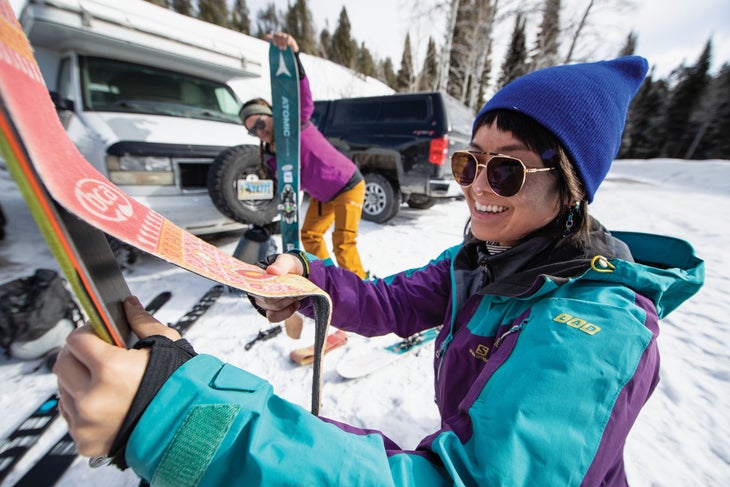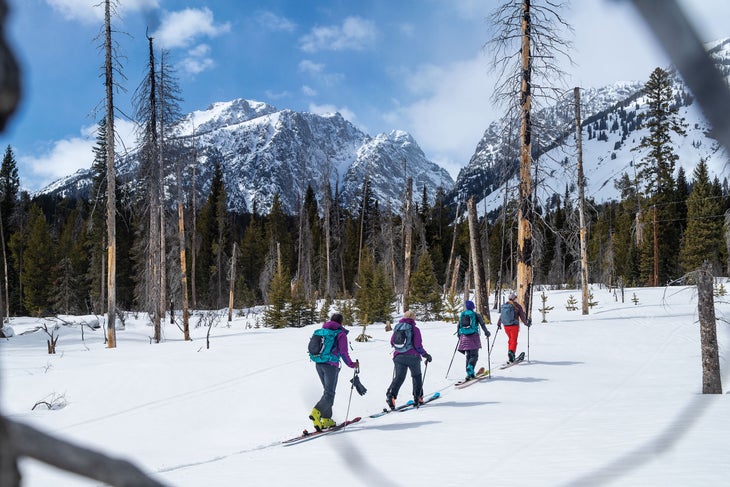Heading out the door? Read this article on the new Outside+ app available now on iOS devices for members! Download the app.
Raised in Idaho’s Selkirk Mountains, Jessica Baker is one of only 17 AMGA female mountain guides in the U.S. Her impressive resume includes first descents across Alaska, the Tetons, the Sawtooths, on Greenland’s glaciers, and Norway’s Svalbard Alps. As a pioneer in the field, Baker’s contributions extend beyond her own skiing achievements to include a strong commitment to promoting diversity in skiing through her Ski Divas Camps.

Promoting Diversity in Skiing: The Impact of Ski Divas Camps
Baker feels most at home in big mountains, but she knows that’s not the case for all women. The lack of female representation in skiing, climbing, and guiding has always weighed on her, so in 2007, she started Ski Divas Camps to bring more women into skiing. Realizing she wanted to make it truly inclusive—not just for women, but for a diverse community of skiers—she hosted the first BIPOC-focused camp at her home in the Tetons last winter. The three-day camp brought together Black, Latinx, Asian, and Native women to connect, learn, and support each other through skiing.
“The majority of the time, White-led initiatives fail Black, Indigenous, and People of Color when it comes to actually creating a safe space for inclusion,” says Annette Diggs, a ski instructor who attended the camp. “Oftentimes, organizations come across as performative. Jessica’s camp offered a refreshing and genuine approach to White-led inclusion work.”
Baker concedes that the camp is just a first step but hopes it will build momentum for change within the ski industry.

The Importance of BIPOC-Focused Ski Camps
SKI spoke with Baker about the state of diversity in the ski industry, leading all-female BIPOC camps, and her role in bringing inclusivity to the sport. Here are the highlights:
“It’s empowering to navigate the mountains on my own. I want more people to have the opportunity to go out there and discover what that feels like.”
“I always wanted female mentorship when I started my career. There were so few women, and it was so competitive. I realized if I wanted to see more women in skiing, I needed to actively support other women.”
“A mentor is a leader in the truest sense. Someone who knows when to teach, when to support, when to be a critic, and knows when to step back to allow others to rise up.”
“There are tons of programs to bring more women into skiing, but these programs are still predominantly aimed at white women.”
“Posting my support for the BIPOC community on social media just wasn’t going to cut it. I wanted to act within my sphere of expertise.”
“It was really important to make the camp a safe space to have difficult conversations. Over the course of three days, we were able to grow together and be vulnerable. I feel lucky to have been able to learn from these women.”
“I’m not perfect, I know I’m still learning. We need to recognize that even if we’re not intentionally excluding BIPOC skiers, we’ve shut out diversity in skiing through socioeconomic barriers and because we’re not welcoming.”
“I’m not entirely sure skiing is the best place to tackle these topics. They need to be tackled in every grain of our society. But when you take tough topics to the mountains, you provide a platform for communication where everyone can connect over a sport, in nature.”
“Mountains are indifferent. Mountains exist—they don’t judge. They just are. Perhaps we could learn a thing or two about that.”
